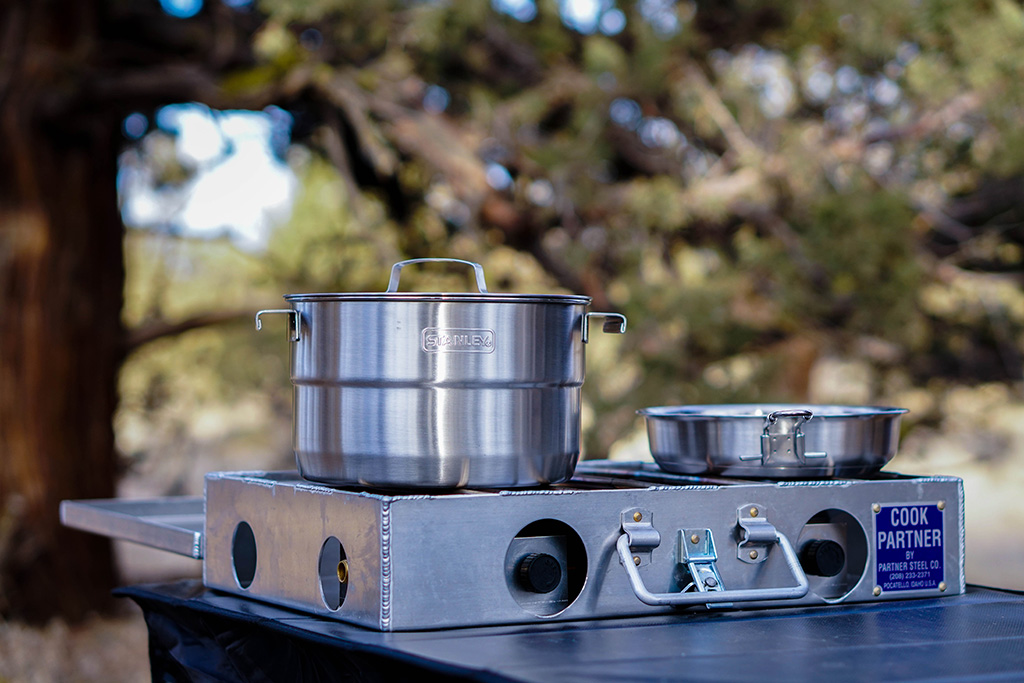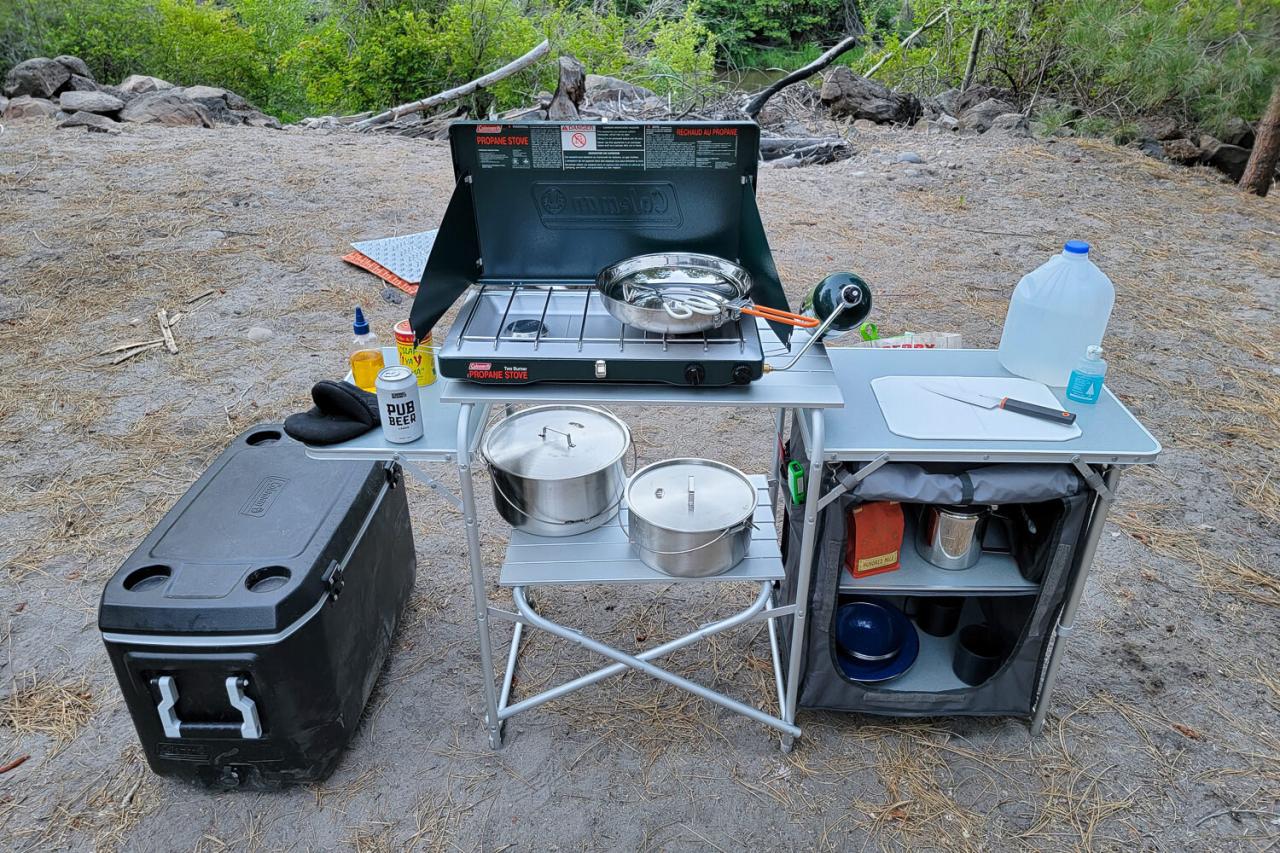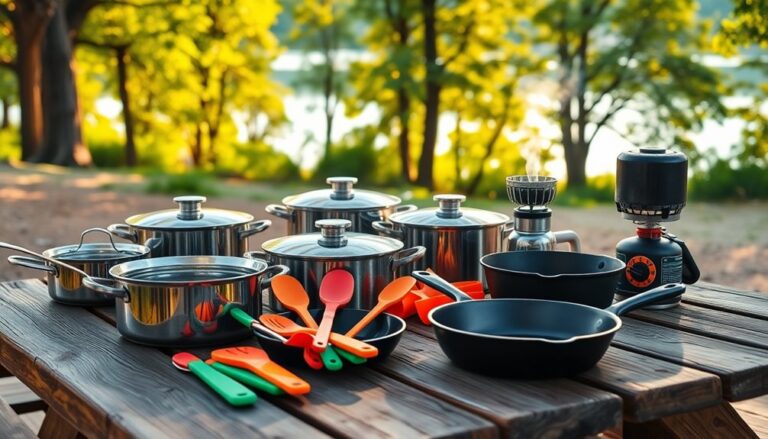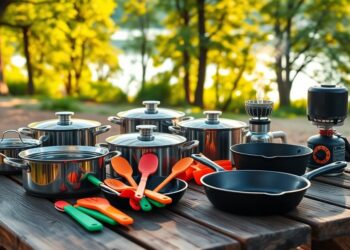Embarking on an outdoor adventure, whether it’s a serene weekend of car camping or an exhilarating multi-day backcountry trek, is often deeply intertwined with the joy of good food. And to truly savor delicious meals in the wilderness, having the right camping cookware is absolutely essential. Gone are the days when a simple pot and pan sufficed; modern advancements in materials, design, and functionality have revolutionized the outdoor kitchen. This comprehensive article delves into the must-have camping cookware, dissecting various types, materials, and features that make a significant difference in your outdoor culinary experience. From ultra-lightweight solutions for backpackers to robust sets for family camping, discover how smart choices in cookware can transform your wilderness meals from basic sustenance to gourmet delights, making every bite a highlight of your adventure.
Camping Cookware Materials

The material of your camping cookware is a primary factor influencing its weight, heat distribution, durability, and ease of cleaning. Each material offers distinct advantages for different camping styles.
A. Aluminum
Aluminum cookware is a popular choice for its excellent heat conductivity and lightweight nature, making it a favorite among backpackers and budget-conscious campers.
- Anodized Aluminum: This is a significant upgrade from basic aluminum. Hard-anodized aluminum undergoes an electrochemical process that creates a harder, more durable, and corrosion-resistant surface. This surface is often non-stick, making cooking and cleaning easier. It also distributes heat more evenly than untreated aluminum, preventing hot spots.
- Benefits:
- Lightweight: Crucial for backpacking where every ounce counts.
- Excellent Heat Conductivity: Heats up quickly and evenly, reducing fuel consumption.
- Affordable: Generally less expensive than stainless steel or titanium.
- Considerations: Can dent more easily than stainless steel. Non-anodized aluminum can react with acidic foods, imparting a metallic taste.
B. Stainless Steel
Stainless steel cookware is renowned for its exceptional durability, corrosion resistance, and ease of cleaning, making it a robust choice for car camping, family trips, or situations where longevity is prioritized.
- Construction: Often features a clad (layered) construction with an aluminum or copper core sandwiched between stainless steel layers to improve heat distribution, as stainless steel alone is not the best conductor.
- Benefits:
- Extremely Durable: Highly resistant to scratches, dents, and corrosion, built to last for many years of rugged outdoor use.
- Easy to Clean: Non-reactive with food and straightforward to wash, even with limited water.
- Versatile: Can handle high heat and is suitable for various cooking methods, including direct campfire cooking (though may blacken).
- Considerations: Heavier than aluminum or titanium, which can be a drawback for backpackers. May have hot spots if not clad properly.
C. Titanium
For the minimalist backpacker or thru-hiker where every gram matters, titanium cookware is the ultimate lightweight solution.
- Strength-to-Weight Ratio: Titanium boasts an incredible strength-to-weight ratio, making it exceptionally light yet incredibly strong and durable. It’s almost as strong as steel but weighs significantly less than aluminum.
- Benefits:
- Ultralight: The lightest option available, making a noticeable difference in backpack weight.
- Extremely Durable: Highly resistant to corrosion and very strong for its weight.
- Non-Reactive: Does not react with food and is easy to clean.
- Considerations: Poor heat distribution (prone to hot spots), so requires careful cooking to prevent scorching. Can be expensive. Best for boiling water quickly rather than elaborate cooking.
D. Cast Iron
While heavy, cast iron cookware offers unmatched heat retention and even cooking, providing a rustic and robust cooking experience, primarily for car camping or fixed campsites.
- Heat Retention: Cast iron excels at retaining heat, ensuring food cooks evenly and stays warm longer. It creates an excellent non-stick surface once properly seasoned.
- Benefits:
- Exceptional Heat Distribution: Once heated, it cooks very evenly.
- Durable: With proper care, cast iron can last a lifetime and even improve with age.
- Versatile: Ideal for simmering, frying, baking (in Dutch ovens), and direct campfire cooking.
- Considerations: Very heavy, making it unsuitable for backpacking. Requires careful seasoning and maintenance to prevent rust.
Essential Cookware Pieces
A well-rounded camping cookware kit usually includes several versatile pieces that can handle a range of outdoor culinary needs.
A. Pots
A good camping pot is the foundation for boiling water, simmering stews, or cooking pasta.
- Capacity: Choose a capacity appropriate for your group size (e.g., 0.6-1 liter for solo, 1.5-2 liters for 2-3 people, 3+ liters for families).
- Lid with Strainer: A lid that doubles as a strainer or has steam vents is incredibly useful.
- Integrated Heat Exchanger: Some high-efficiency pots feature an integrated heat exchanger at the bottom, which captures more heat from the stove, significantly reducing boil times and fuel consumption, especially beneficial for backpackers.
- Folding Handles: Handles that fold or detach make packing easier and safer.
B. Pans/Skillets
A camping pan or skillet is essential for frying eggs, cooking pancakes, or sautéing vegetables.
- Non-Stick Coating: For ease of cooking and cleaning in the wilderness, a durable non-stick coating is highly recommended. Look for PFOA-free coatings.
- Size: A 7-10 inch diameter pan is generally versatile for 1-3 people.
- Heat Distribution: Choose a pan material known for good heat distribution to prevent burnt spots.
- Detachable/Folding Handles: For compact packing.
C. Kettles
A dedicated camping kettle is a luxury that quickly becomes a necessity for hot drinks, instant meals, or quick water boiling.
- Boil Speed: Kettles are designed for efficient water boiling. Look for models with a wide base for maximum heat transfer.
- Pour Spout: A controlled pour spout makes serving hot beverages safer and easier.
- Capacity: A 0.8-1.5 liter capacity is generally sufficient for small groups.
D. Nested Cookware Sets
Many manufacturers offer nested cookware sets where pots, pans, lids, and even bowls or mugs fit inside one another.
- Space Efficiency: This design is incredibly space-efficient, taking up minimal room in a backpack or car.
- Completeness: Provides a comprehensive cooking solution in a compact package.
- Components: Check that the set includes the specific items you’ll use most frequently.
Utensils and Prep Tools

Even with the best cookware, you’ll need the right utensils and prep tools to prepare and serve your meals efficiently.
A. Spatulas and Ladles
- Heat-Resistant Materials: Choose spatulas and ladles made from heat-resistant nylon, silicone, or wood to avoid scratching non-stick coatings.
- Folding/Collapsible Designs: Many camping utensils are designed to fold or collapse for compact storage.
- Multi-Purpose Utensils: Look for utensils that can serve multiple functions to reduce the number of items carried (e.g., a spork, or a spatula with a serrated edge).
B. Cutting Boards and Knives
- Compact Cutting Board: A small, lightweight, and foldable or rollable cutting board made from durable plastic or bamboo is essential for safe food preparation.
- Sharp Camping Knife: A dedicated camping knife (fixed blade or sturdy folding knife) with a sharp, stainless steel blade is crucial for chopping vegetables, slicing meat, and various utility tasks. Ensure it’s easy to clean.
- Knife Sharpener: A compact knife sharpener ensures your blade stays keen throughout your trip.
C. Can Opener and Bottle Opener
Don’t forget the basics! A compact can opener and bottle opener are indispensable for many packaged food items and beverages. Many multi-tools include these features.
D. Grippers and Pot Holders
- Pot Grippers: For handles that detach or get too hot, a dedicated pot gripper provides a secure way to lift and move hot pots and pans.
- Heat-Resistant Pot Holders/Gloves: Small, lightweight silicone or fabric pot holders protect your hands from hot surfaces.
Cooking Methods and Stove Compatibility
Your choice of camping cookware should be compatible with your primary cooking method and stove.
A. Backpacking Stoves
- Canister Stoves: Lightweight and compact, often best paired with titanium or hard-anodized aluminum for rapid boiling and minimal weight.
- Liquid Fuel Stoves: More robust and versatile, can use various fuels. Still generally paired with lightweight pots.
- Wood Gas Stoves: Use twigs and biomass for fuel, great for boiling water. Cookware needs to be able to handle direct flame.
- Integrated Canister Systems: All-in-one systems (e.g., Jetboil) are designed for ultra-fast boiling and often come with a purpose-built pot.
B. Car Camping Stoves
- Propane Camp Stoves: Often two-burner systems, these can handle a wider variety of cookware, including heavier stainless steel or even smaller cast iron pieces.
- Grills and Griddles: Dedicated camp grills or griddles allow for versatile cooking of meats, pancakes, and more.
C. Campfire Cooking
- Direct Flame Cookware: Cast iron is king for direct campfire cooking, offering excellent heat retention and durability against open flames. Stainless steel can also be used, but may blacken.
- Grates and Tripods: A campfire grate or a tripod system allows you to suspend pots and pans over the fire for more controlled cooking.
- Foil Packet Cooking: Simple and effective, using heavy-duty aluminum foil to cook food directly in the embers.
Purchasing Considerations and Future Trends
Selecting the right camping cookware involves balancing multiple factors to match your specific outdoor adventures.
A. Key Purchasing Factors
- Camping Style: Are you backpacking (prioritize weight), car camping (durability and capacity), or a mix?
- Group Size: How many people will you typically be cooking for? This determines the necessary pot and pan capacities.
- Food Preferences: Do you primarily boil water for dehydrated meals, or do you enjoy elaborate cooking? This influences the types of pieces you need.
- Weight and Packability: For backpackers, check the total weight of the set and how compactly it nests.
- Durability: Consider how robust you need the cookware to be, especially if it will endure rough treatment.
- Budget: Cookware prices vary widely by material and brand. Set a realistic budget.
- Ease of Cleaning: In the backcountry, easy-to-clean surfaces are a major plus.
- Stove Compatibility: Ensure the cookware’s base diameter is suitable for your stove’s burner size and pot supports.
B. Emerging Trends in Camping Cookware
- Integrated Smart Features: While still nascent, future cookware might integrate temperature sensors that communicate with smart stoves or apps, providing precise cooking control.
- Modular and Multi-Use Designs: Even greater emphasis on multi-functional pieces that can serve as pots, pans, bowls, or even lids, maximizing utility while minimizing carry weight.
- Sustainable Materials: Development of more eco-friendly and responsibly sourced materials for outdoor cookware, focusing on reduced environmental impact throughout the product lifecycle.
- Advanced Non-Stick Coatings: Research into more durable, long-lasting, and truly non-toxic non-stick coatings that can withstand the rigors of outdoor use.
- Ultralight Composite Materials: Exploration of new composite materials that offer the strength of metals with even lighter weights, potentially revolutionizing ultralight backcountry cooking.
Conclusion
Your choice of camping cookware is a crucial element that can transform your outdoor eating experiences from mere sustenance to memorable culinary adventures. By understanding the properties of different materials, selecting the right pieces for your needs, and embracing smart practices for cooking and cleaning, you empower yourself to create delicious, nourishing meals even in the most remote settings.
Whether you’re a seasoned chef of the backcountry or just beginning your outdoor cooking journey, investing in quality, functional cookware is an investment in your comfort, satisfaction, and overall enjoyment of nature. So, pack wisely, cook with passion, and let your outdoor kitchen be a source of joy and energy for all your wilderness explorations.









